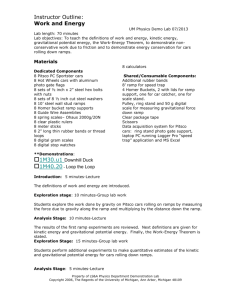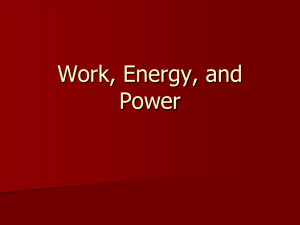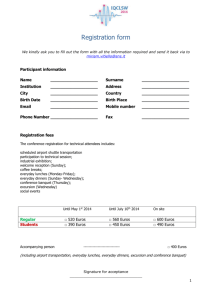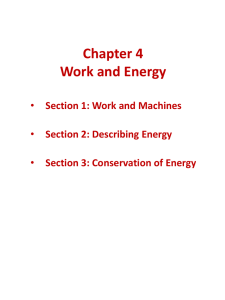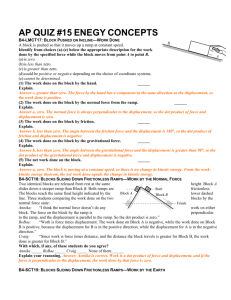2015 AP Physics 2 - Branham High School
advertisement
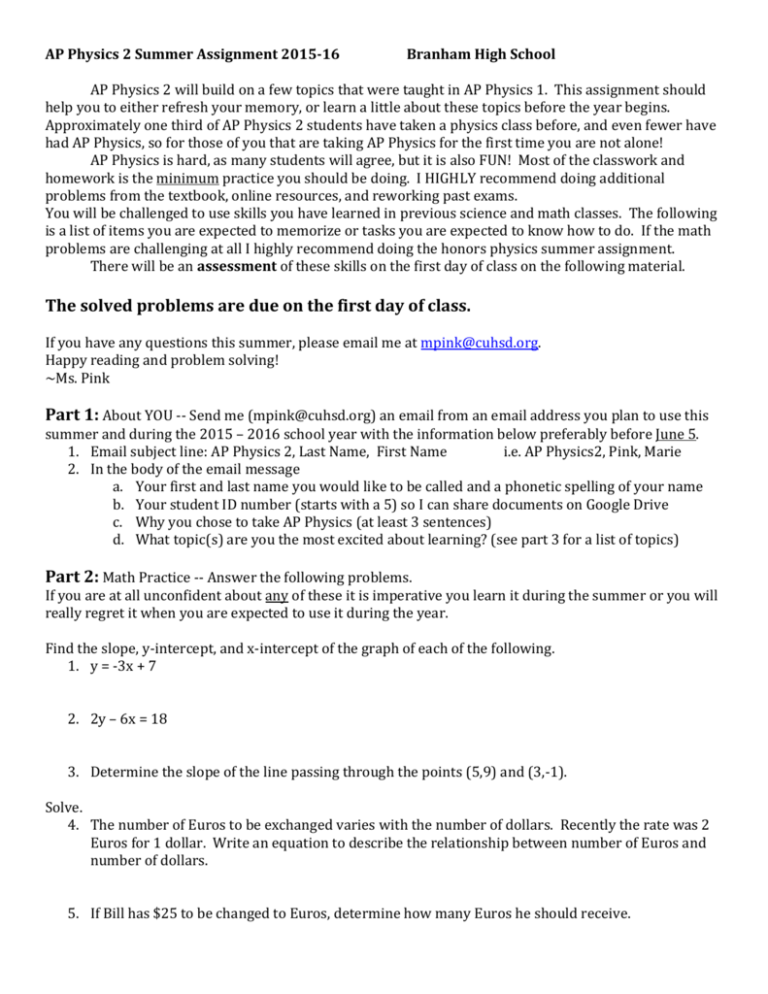
AP Physics 2 Summer Assignment 2015-16 Branham High School AP Physics 2 will build on a few topics that were taught in AP Physics 1. This assignment should help you to either refresh your memory, or learn a little about these topics before the year begins. Approximately one third of AP Physics 2 students have taken a physics class before, and even fewer have had AP Physics, so for those of you that are taking AP Physics for the first time you are not alone! AP Physics is hard, as many students will agree, but it is also FUN! Most of the classwork and homework is the minimum practice you should be doing. I HIGHLY recommend doing additional problems from the textbook, online resources, and reworking past exams. You will be challenged to use skills you have learned in previous science and math classes. The following is a list of items you are expected to memorize or tasks you are expected to know how to do. If the math problems are challenging at all I highly recommend doing the honors physics summer assignment. There will be an assessment of these skills on the first day of class on the following material. The solved problems are due on the first day of class. If you have any questions this summer, please email me at mpink@cuhsd.org. Happy reading and problem solving! ~Ms. Pink Part 1: About YOU -- Send me (mpink@cuhsd.org) an email from an email address you plan to use this summer and during the 2015 – 2016 school year with the information below preferably before June 5. 1. Email subject line: AP Physics 2, Last Name, First Name i.e. AP Physics2, Pink, Marie 2. In the body of the email message a. Your first and last name you would like to be called and a phonetic spelling of your name b. Your student ID number (starts with a 5) so I can share documents on Google Drive c. Why you chose to take AP Physics (at least 3 sentences) d. What topic(s) are you the most excited about learning? (see part 3 for a list of topics) Part 2: Math Practice -- Answer the following problems. If you are at all unconfident about any of these it is imperative you learn it during the summer or you will really regret it when you are expected to use it during the year. Find the slope, y-intercept, and x-intercept of the graph of each of the following. 1. y = -3x + 7 2. 2y – 6x = 18 3. Determine the slope of the line passing through the points (5,9) and (3,-1). Solve. 4. The number of Euros to be exchanged varies with the number of dollars. Recently the rate was 2 Euros for 1 dollar. Write an equation to describe the relationship between number of Euros and number of dollars. 5. If Bill has $25 to be changed to Euros, determine how many Euros he should receive. Solve each system of equations algebraically. 6. x + y = 17 x–y=7 7. 6x + 7y = 19 x+y=5 8. x + 2y – 3z = 5 x – y + 2z = -3 x+y–z=2 For number 9-15 rearrange the equation to solve for the variable to the right of the equation 9. P = P0 + ρgh h= 10. P1 + ρgh + ½ ρv12 = X v1 = 11. n1 sinϴ1 = n2sinϴ2 ϴ1 = 12. d sinϴ = mλ ϴ= 13. d sinϴ = mλ λ= 14. Fg = 𝐺 𝑚1 𝑚2 𝑟2 m1 = r= 1 15. E = 4𝜋𝜀 𝑞 𝑜 𝑟2 εo = r= Solve for each unknown value in the right triangle. The triangle is not drawn to scale! 16. A = 15 and b = 10 17. B = 42 and b = 12 18. A = 68 and c = 8 19. b=10 and a=19 20. a=6 and c=16 Solve each problem 21. The top of a lighthouse is 52 feet above sea level. A man sailing a boat at sea observes the measure of the angle of elevation at the top of the lighthouse to be 39. How far is the boat from the foot of the lighthouse? 22. A ramp is 10 feet long. The bottom of the ramp rests on the ground and top of the ramp is 3 feet above the ground. What is the angle (in degrees) formed by the ramp and the ground? Fractions! Solve for the unknown values below 23. + 𝟏 𝟏 𝟖 𝟒 24. + 𝟏 𝟏 𝟑 𝟔 𝟏 𝟏 𝟖 𝑹 25. + m=_______________________ =𝒎 = = 𝟏 p=_______________________ 𝒑 𝟏 R=_______________________ 𝟐 Metric System Prefixes Unit Symbols Factor Numerically In words Prefix Symbol 109 106 103 102 101 10-1 10-2 10-3 10-6 10-9 1 000 000 000 1 000 000 1 000 100 10 0,1 0,01 0,001 0,000 001 0,000 000 001 billion million thousand hundred ten tenth hundredth thousandth millionth billionth gigamegakilohectodecadecicentimillimicronano- G M k h da d c m µ n Give the following answers in scientific notation 26. 10-5 • 10-6 = 27. 4.0 • 103 + 6.1 • 103 = 28. 7.0 • 10-9 + 3.2 • 10-8 = 29. (1.6 • 10-3 ) • (8.2 • 105) = 30. 8.5 • 10-6 - 2.3 • 10-6 = meter kilogram second ampere kelvin watt Coulomb volt Electron Volt m kg s A K W C V eV mole hertz newton pascal joule farad tesla Ohm henry mol Hz N Pa J F T Ω H Part 3: Familiarizing Yourself With Content This is a comprehensive list of the topics we will cover during AP Physics 2 incase you would like to get a head start. Write one sentence that describes what each of these mean (I recommend googling them) and give an example of how the physics is used. For example, Conservation of energy is used to design cars. Fluid Statics and Dynamics Thermodynamics with Kinetic Theory PV Diagrams and Probability Electrostatics Electrical Circuits with Capacitors Magnetic Fields Electromagnetism Physical and Geometric Optics Quantum, Atomic, and Nuclear Physics The things to know before the first day of class are outlined below: Energy – The stuff that makes stuff do stuff This is the most general definition we use for energy. Know it! The following are types of mechanical energy that were studied in the first year of physics Gravitational Potential Energy (GPE or UG = mass*g*height = mgh) – the energy stored in an object due to how high it is. Kinetic Energy (KE = ½ mass*velocity squared = ½ mv2) – the energy stored in an object because it is MOVING. Kinetic means “of or related to the movement of objects” Spring Potential Energy (SPE = Uspring = ½ kx2)- the amount of energy stored in a compressed/stretched spring. k=spring constant, x = how much the spring is stretched/compressed from its equilibrium position Work - equivalent to the change in energy of a system In mechanics we calculated work by multiplying the force applied on an object by the distance it moved as a result (the displacement) - for those of you in calculus this is also the integral of the force vs. displacement graph As a heads up we will spend a great deal more time on work this year to talk about work being done ON a system and work done BY a system Both work and energy are measured in Joules (J) Forces are measured in Newtons (N) Vocabulary to Know: Displacement, velocity, acceleration, slope, area, voltage, current, resistance, Ohms, Amps, Volts, multimeter, potential energy, kinetic energy, spring constant, gravitational force, gravitational field strength, g, free fall, forces, normal force, gravitational force, push/pull force, tension force, Newtons. There are more words than these, but this is a good start.







